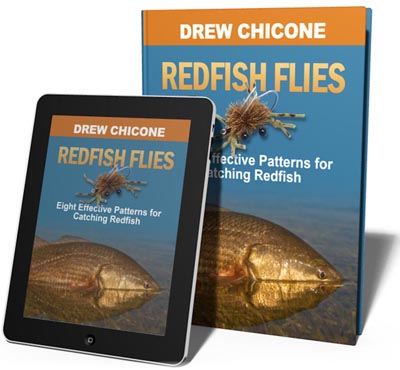[dropcap]A[/dropcap]t the suggestion of Don Reed, a friend of a half dozen years, remarkable and innovative fly tyer, and former fly tying editor for Fly Life Magazine.com, I was coaxed into a purchase. A fly tying book. I needed another fly tying book like I needed a flat tire, but what the heck I said, and pulled the trigger. Don is a persuasive guy. Don owns Saltwater Fly Tyers in St. Augustine, Florida, a full service fly shop that has a superior tying coach-house for beginners to advanced tyers.
The book was written by Drew Chicone, a well-known entity with regard to fly tying, writing about it as well as teaching it. Too, this particular book, Redfish Flies: Eight Effective Patterns for Catching Redfish was probably what the doctor ordered. I needed some help. I was in redfish country, Savannah, Georgia and not doing too well. The patterns I use in South Florida (Everglades National Park) and those I use along the west coast of Florida (Gulf of Mexico) all the way up to up to Boca Grande are not as effective here in the chocolate-colored inland waters around Savannah.
The oceanside grass flats are the most productive for reds in North Florida, Georgia, South Carolina and portions of North Carolina. I haven’t experienced the clear water grass flats here yet, but have been invited to do so by Bryan O’Dell, manager of Rivers & Glen Trading Co., Savannah’s only, and brand new, fly shop. One worth a visit. O’Dell and his sidekick Jamie Giello know everything there is to know about fly fishing Savannah’s bounty.
OMG!
When the book arrived last week, I gave it a cursory page flip overview. First impression; it looked like a book for children: huge images, huge fonts, exaggerated leading and too much air. My background in design got in the way.
Hold on there
A few days ago, after being skunked by tailers, I went to the bench with Drew’s book and splayed it open to Pine Island Ice Tea. A fly construction that met both my skill level, versatility to catch other game fish, durability (Crystal Chenille, Pseudo Eyes) and Bucktail which inherently avoids tail fouling like marabou and feathers do, visibility in chocolate water and a natural enough swimmer to get up close and personal with snook and other flats visitors. In addition, because the weighted eyes are tied further back on the hook, it will swim level when intermediate or sinking line are in-play. A weed guard makes the fly very useful in grass flats or where there is unseen debris.
Further examination of Drew’s book reveals
- The oversize instruction images, unique to Drew’s approach, are valuable to any skill level tyer, but a godsend to guys and gals operating with extra thumbs – like me. How many times have those three or four, one inch by one inch, instructional images managed to leave you in the dark because they don’t go from B to C but B to E?
- Drew’s recipe treatments are flawless. Everything is called out. No guessing.
- The book is not all about Drew’s patterns. He selected some of the best tyers he knows and fit them into his format. A great combo.
- The best part of the book might well be that Drew questions each tyer about “HOW” and “WHY.” The tyers represented in the book let the reader in on why the patterns were developed, how they are used (some have multiple applications), how they are swum and if a pattern morphed over time and “HOW” and “WHY.”
- What was perceived as an ugly layout turned out to be the strength of the REDFISH FLIES; one illustration per page, explicit instructions per that illustration – leaving no doubt as to how-to. For example, the Pine Island Ice Tea Fly, tied by Capt. Daniel Andrews is a seven illustrations fly build. Some fly recipes and illustrations within the book have, of course, more or less instructional pages. You are never in the dark. The steps are clearly marked – no tripping allowed.
Summing up the book

Capt. Daniel Andrews’ Pine Island Ice Tea fly. Capt. Andrews’ website.
I was able to tie a really attractive (unusual for me), good swimming Pine Island Ice Tea fly pattern. It’s next hook-up will be the sixth, which I hope will be today – if I can get away from this damnable machine.
I’ve ordered some of Drew’s Chicone’s other fly tying titles. I hope they all look like a book for elementary school children.
[information]
Don Reed’s Saltwater Fly Tyers . . .
[/information]



